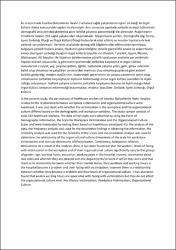İşyeri Zorbalığı ile Örgüt Kültürü İlişkisi: Bahçelievler Devlet Hastanesi Örneği
Abstract
Bu araştırmada İstanbul Bahçelievler Devlet Hastanesi sağlık çalışanlarının işyeri zorbalığı ile örgüt kültürü ilişkisi konusundaki algıları incelenmiştir. Aynı zamanda işyerinde zorbalık ve örgüt kültürünün demografik ve iş yeri değişkenlerine göre farklılık gösterip göstermediği ele alınmıştır. Araştırmanın örneklemi toplam 218 sağlık çalışanından oluşmaktadır. Araştırmanın verileri, Demografik bilgi formu, İşyeri Zorbalığı Ölçeği ve Örgüt Kültürü Ölçeği kullanılarak elde edilmiş ve kurulan hipotezlerle test edilerek yorumlanmıştır. Verilerin analizinde demografik bilgilerin elde edilmesinde tanımlayıcı bulgulara yönelik frekans analizi, ölçeklerin güvenilirliğine yönelik güvenilirlik analizi ve araştırmanın amacı olan işyeri zorbalığı ölçeğinin örgüt kültürü boyutlarının (Katılım, Tutarlılık, Uyum, Misyon, Motivasyon) Alt Boyutları ile ilişkisinin belirlenmesine yönelik korelasyon analizine yer verilmiştir. Yapılan analizin sonucunda, iş görenlerin işyerlerinde zorbalıkla karşılaşma ve örgüt kültürü seviyelerinin cinsiyet, yaş, çalışma saatleri, eğitim, hastanede çalışma yılları, gelir, görev rollerinin belirli olup olmaması ve çalıştıkları servislerden memnun olup olmama gruplarına göre anlamlı farklılık gösterdiği, medeni statülerinin, hastanedeki görevlerinin ve çalışma saatlerinin sorun olup olmamasının zorbalıkla karşılaşma ile ilişkisinin bulunmadığı ancak örgüt kültürü seviyeleri ile ilişkili olduğu anlaşılmıştır. Haftalık çalışma süresinin zorbalıkla karşılaşma durumu ile ilişkili olduğu fakat örgüt kültürü seviyesini etkilemediği bulunmuştur. Anahtar Sözcükler: Zorbalık, İşyeri Zorbalığı, Örgüt Kültürü. In the present study, the perceptions of healthcare workers of Istanbul Bahçelievler State Hospital related to the relationship between workplace victimization and organizational culture were examined. It was also dealt with whether the victimization in the workplace and the organizational culture differed based on the demographic and workplace variables. The study sample consists of total 192 healthcare workers. The data of the study were obtained by using the Form of Demographic Information, the Scale for Workplace Victimization and the Organizational Culture Scale, and were interpreted by testing them based on hypotheses developed. For the analysis of the data, the frequency analysis was used for the descriptive findings in obtaining the information, the reliability analysis was used for the reliability of the scales and the correlation analysis was used to determine the relationship of the organizational culture dimensions of the scale for workplace victimization with the sub-dimensions of (Participation, Consistency, Adaptation, Mission, Motivation). As a result of the analyses done, it has been found out that the workers' levels of facing with victimization in the workplace and of their organizational culture significantly vary by the groups of gender, age, working hours, education, working years in the hospital, income, uncertainty about task roles and whether they are pleased with the departments/services in which they work and that there is no relationship between whether their marital status, their positions and working hours in the hospital become a problem and their facing with victimization; however there is a relationship between whether they become a problem and their levels of organizational culture. It has also been found that weekly working hours are associated with facing with victimization but they do not affect the organizational culture level. Key Words: Victimization, Workplace Victimization, Organizational Culture.
Collections
- Yüksek Lisans Tezleri [572]

















